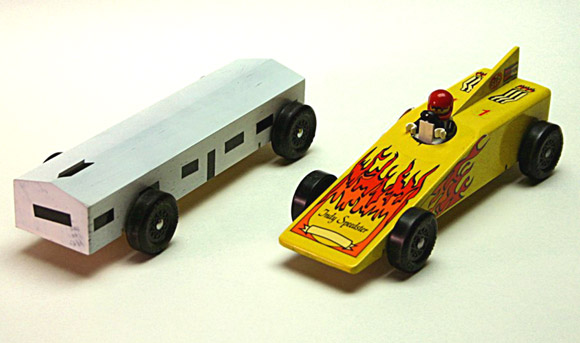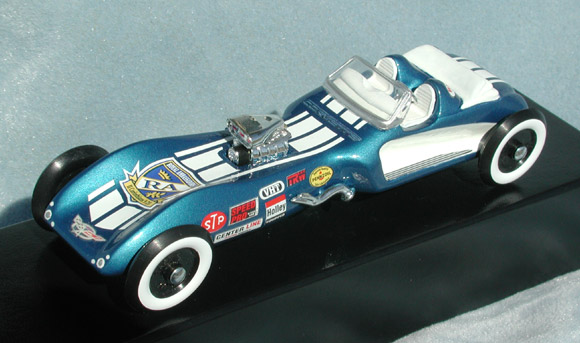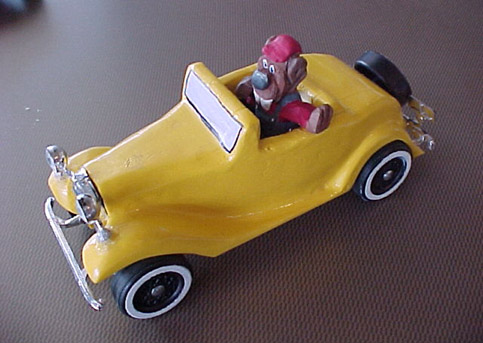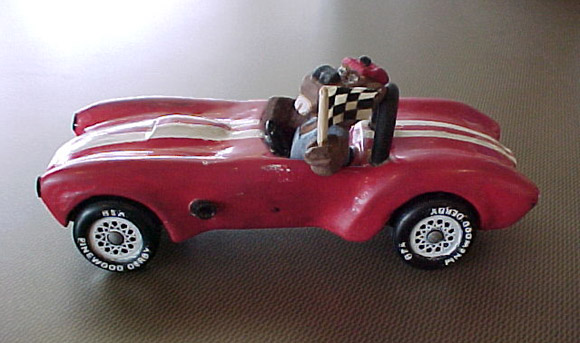In this Edition:
– Feature Article – Designing a Car From Scratch
– Car Showcase
– Memory – Pinewood Derby Prayer
– Q&A
Designing a Car From Scratch
I have been asked several times, “How do you come up with your designs?” The obvious answer is ‘imagination’, but really I am not the most imaginative person around. A better answer is that I think about car designs on a regular basis. I am also a ‘doodler’. When I have a piece of paper and a pencil I tend to sketch out car profiles. I have found if I do this enough, I eventually come up with something useful.
Of course there is more to designing a car than just sketching out a profile. The car must also meet various criteria, some imposed by the rules, and others that are needed for good performance. In this article I will share with you some of the things I have learned about car design, which I trust you will find useful when it comes time to design your own car.
Design Considerations
When the derby race date is approaching and time is at a premium, it is tempting to draw a few lines and start cutting. But before you do that, ask yourself a few questions:
- Weight: Depending on how much wood you remove, you will need to add between 2.5 to 3.5 ounces of weight. Too often car builders don’t consider the need to add weight until after the car is shaped and painted. At that time it is difficult to add any weight, much less add enough weight at the best location.So, when designing a car, make sure to consider the following:
- Weight Amount: Make an estimate as to how much weight must be added to achieve maximum weight. The amount will depend on the amount of wood that is removed and the density of the wood. When I design a car, I use previous models as a guideline, and I build several prototypes until I get it right. If desired and time permits, you can build prototypes as well. But if not, the weight uncertainty can be dealt with (see ‘Weight Placement’ below).
- Weight Type: Determine the type of weight (shape and material). The density of the weight makes a huge difference as to how much space will be required to hold the weight (See Figure 1 which shows the relative density of three popular weight types). Clearly much more space must be reserved for zinc weight than for tungsten weight.
Figure 1 – Density Comparison of Popular Weight Types
- Weight Placement: For best performance on the most popular track lengths (32-45 feet) the center of gravity (the front-to-back balance point of the completed car) should be located between 1 and 1-1/4 inches in front of the rear axle. To achieve this balance point, a ‘rule of thumb’ is to place 1/3 of the added weight behind the rear axle, 1/3 on top of or just in front of the rear axle, and the final 1/3 about 1-1/2 inches in front of the rear axle.I suggest embedding all of the weight in the car, as opposed to having it hang below the bottom of the car. I oftentimes embed about 2/3 of the weight in the car such that it is not visible. This is done with holes, or with pockets that are covered with wood filler. The remaining 1/3 of the weight is embedded into the bottom, so that it can be adjusted at the weigh-in. If the amount of weight needed is uncertain or if you don’t have access to a scale, you can create holes/pockets for the final 1/3 of the weight, but wait until the weigh-in to install it.
- Axle Location: For standard wheelbase cars (such as BSA kits), best performance is generally achieved by using the axle slot closest to the end of the block as the rear axle. This is just the opposite of the car pictured on the kit box.
- Wheel Base: If allowed by the local rules, extend the wheel base to the maximum length. Long wheelbase cars go straighter, are more stable, and allow the center of gravity to be located further towards the rear of the car. For the opposite reasons do not shorten the wheelbase.
- Aerodynamics: The fastest cars tend to be low-slung and aerodynamic. While the amount of effect from wind drag on a derby car is a secondary speed factor, it is prudent to recognize the presence of wind drag and avoid design features that would increase this effect. Thus, use a basically aerodynamic design, and avoid the use of accessories that could catch air such as sails, streamers, etc. Also, rounding off the leading and trailing edges of the car serves to reduce aerodynamic drag.
- Symmetry: An important design factor that affects the speed of a car is left-to-right symmetry. By this I mean that the left side of the car should be a mirror image of the right side of the car (see Figure 2 for an example of a non-symmetrical car). Why is symmetry important? Because a car that is not symmetrical will be heavier on one side, and will tend to ‘steer’ to that side. Thus, after the wheels/axles are adjusted to make the car roll straight, there will be an increase in friction as the car tries to turn, but the wheels/axles prevent the turn. This extra friction will slow the car down.
- Blunt Point: Avoid designs that have a sharply pointed front end. There are two reasons for this caution. The first is that most tracks have round rods that hold the cars at the starting line. A car with a sharp point will tend to slip off of the rod, which could cause the car to start at an angle. The second reason for avoiding a sharp point is that the point may not trigger the finish line sensor until the car has progressed a little bit past the finish line. This could be important in a close race. So, make sure that the nose of the car is blunt so that it will sit properly at the starting line and properly trip the finish line.
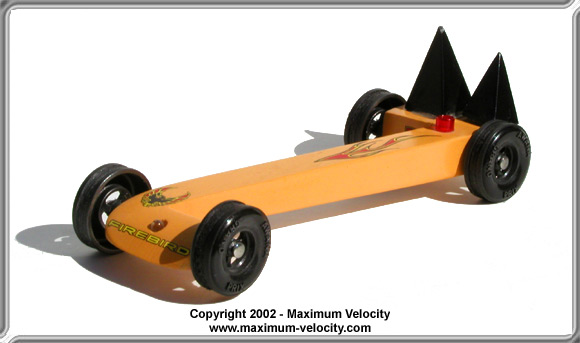
Sketching
Now that you know where the weight will go, get some graph paper. Then in full scale, draw the side profile of the car, then the top view, the bottom view, and the rear view of the car. Note the location of weight pockets and holes. If you don’t like what you have drawn, just do it again. It’s much cheaper and easier to throw away ideas on paper than to throw away a partially worked block of wood!
Multiple Parts
Once you have decided on a design, determine whether the design can be cut directly out of one block, or if it would more easily be built from two or more pieces of wood. For example, the faring on the back of the car in Figure 3 is a separate piece of wood glued to the body. In Figure 4, the wings, the side air intakes, and the faring are separate pieces of wood.
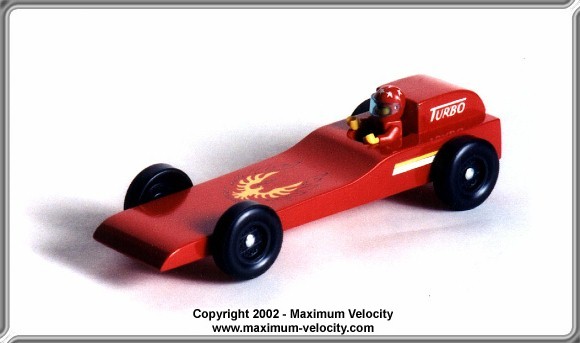
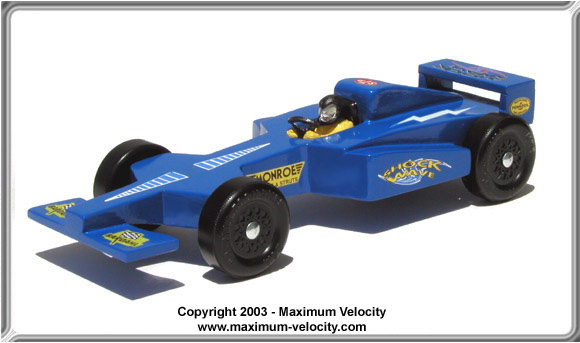
Decorative Items
Finally, decide if you will add on any decorative items such as engines, exhaust pipes, etc. If so, then mark any holes/pockets required for the item. In Figure 5, the roll cage is constructed from aluminum rod. To mount the rods, holes were drilled in the top of the body. In Figure 6, shallow pockets were made to accommodate the pipes and engine. These pockets ensure that the items are firmly glued to the car.
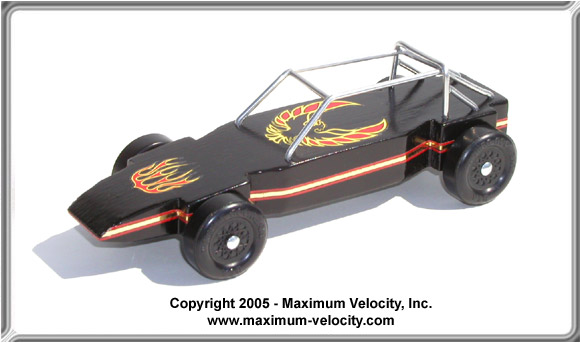
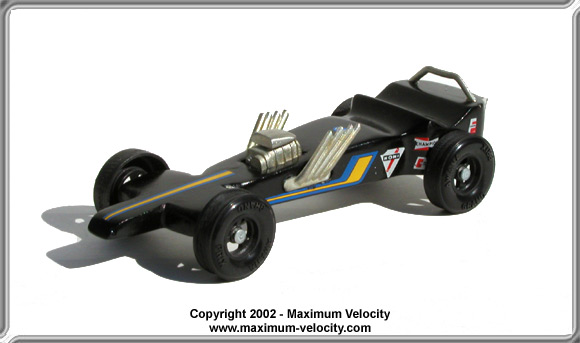
Conclusion
Designing a car on paper can be fun, and will give multiple benefits:
- Save you time by minimizing rework.
- Achieve better performance by ensuring that weight is properly accommodated.
- Simplify construction by identifying holes/pockets that need to be created, and helping you identify multiple parts.
Okay, let the drawing begin!
Car Showcase
Runaway House & Yellow Fireball: Matt & Will Osbourne
These are my son’s cars from their recent pack pinewood derby. On the left is Matt Osbourne’s ‘Runaway House’. He’s a Webelo 1 and this is the fourth car he’s raced. He finished first in rank and had the 8th fastest time in the pack (50 cars in competition). On the right is Will Osbourne’s ‘Yellow Fireball’. He’s a Tiger and this is his first official car. He finished first in rank and had the 6th fastest time in the pack. He’ll be going on to represent his pack at the district races since he was the fastest Tiger. I’ve been reading the newsletter for almost two years and picking up tips. Both racers are three wheelers with a good rear center of gravity and the boys spent a lot of time in front of the drill press polishing the axles until they gleamed. I made a test track this year based upon instructions from a prior year’s newsletter and we had the cars well aligned before test and tune night.‘Vette: Jay & Jay-
Jay Bailey
I recently ordered a DerbyDome for my son Jay-Jay’s pinewood derby race car. He is with the RA’s (which is a church run scouting organization). On March 12, 2005 the RA’s held a regional event in Wilson, North Carolina with over 200 participants from all over the eastern part of North Carolina. The car that we built together won a 1st Place ribbon for most unique design and a trophy for best in show. Jay-Jay turned 7 years old that day, and needless to say, he was elated to win a trophy and a blue ribbon on his birthday! Your DerbyDome will protect and display his winning car for years to come and we thank you for offering such a wonderful product.
WoodBadge Beaver’s ’32 Chevy: David Bivins
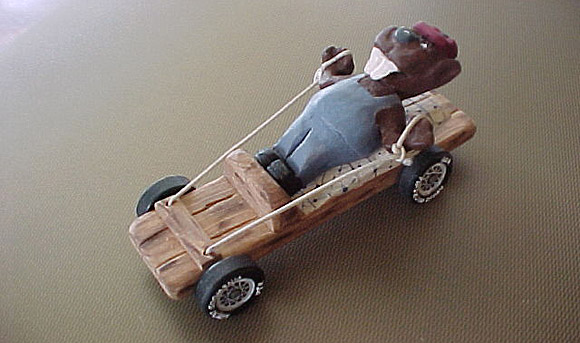
Share Your Pinewood Derby Car Creation
Do you have a car you would like to ‘show off’ to our readers? If so, send us a photo of your car along with a brief description of any special features. Please include your name, city and state. If selected, we will include the photo and description in this Car Showcase section. Please e-mail photos to:
in**@**************ty.com.
Photos must be sent by e-mail in JPG format (minimum size of 640×480 – maximum size of 1280 x 960). Please shoot photos from the front left of the car, similar to the orientation of the cars shown above.
Send only one photo per car, unless an additional photo is needed to adequately show a feature. Also, only one car per subscriber please. Thanks!
Pinewood Derby Memory
The Pinewood Derby Prayer
After I read your newsletter that was forwarded to me by a friend, I felt a need to share a special Pinewood Derby moment in my oldest son’s life. When my son was a Webelos II in Pack 169 in Egham, England, our Cubmaster, Glenn Brace, wrote a Pinewood Derby poem that he read prior to our Derby race. I feel the poem says it all.
The Pinewood Derby Prayer
Hey God, we ask you to draw near
And bless the boys who gather here.
This is the day they’ve waited for
Their blocks of wood are blocks no more.
Plastic wheels and dime store nails
Become the stuff of sporting tales
Of finishes too close to see!
You’re here for every victory.
You bless the winners in their joy
But there’s another kind of boy
Whose handiwork is blessed by you
Because his hands tried something new.
You smile upon the crooked wheel,
The paint job done with boyish zeal,
The splintered car, the sloppy glue.
You love the work that Your sons do.
But there is one here in this place
Who shows the greatness of Your grace.
He is the boy who hasn’t won
But when he hears the starting gun
He’s there to cheer his fellow scouts
His are the loudest victory shouts.
And when his brothers haven’t won,
He’s just the one to say “well done,
You’ve tried your best and you’ve had fun,
There are more races to be run.”
And so, dear God, we hear you say
Upon this happy Derby Day,
“Remember, whether best or worst,
Remember, you are brothers first.”
Glenn Brace
Cubmaster, Pack 169
Submitted by:
Pam Pender Tiger Den Leader, Pack 52
Troop Committee Member, Troop 52
Morgantown, West Virginia
Do You Have a Pinewood Derby Memory to Share?
Now that many races have been completed, I am sure there are many stories to share. Please jot down your humorous, unusual, sad, or heart-warming pinewood derby tale and send it to: in**@**************ty.com
If your story is used, you will receive a free copy of Volume 5 of the Pinewood Derby Times when it is compiled during the summer.
Don’t worry about literary polish. We will edit as needed, and review it with you before publishing.
Q&A
We want to use a wheel mandrel to polish our wheels, but are not sure how to do it. Can you explain how and what to use to polish the wheels for maximum speed?
Chuck up the mandrel in a hand drill; avoid using a Dremel-like tool if possible, as the high RPM can melt the plastic. Then attach the wheel with the screw. Make sure the screw is snug, but don’t over-tighten. I suggest using 600 or 800 grit wet/dry sandpaper as the polishing agent. Note that many mandrels come with coarse sandpaper. Use that sandpaper for sanding wood; DO NOT use it on the wheels. Dip a piece of the 600 or 800 grit sandpaper in water, and then lightly sand the tread surface and the inside edge (the thin edge that will face the car). Sand until the surfaces are smooth, and make sure to keep the sandpaper wet. Note that it is not necessary (or recommended) to sand off the mold mark on BSA wheels. This requires excessive sanding and will result in a lopsided wheel. If you want perfectly round, defect-free wheels, then purchase a set of speed wheels.
I found conflicting information on the Internet. One place states that “smaller diameter axles go faster”, and another states: “Reducing the diameter of the shaft hurts performance unless the wheel hub inside diameter is similarly reduced.” Have any tests been run on this topic, or do you have an opinion? I noticed your outlaw axles for sale are the same diameter as BSA stock.
I go with the second statement. A big difference in shaft diameter versus bore diameter allows too much ‘play’ in the wheels leading to problems. The goal is to have a good axle/bore fit to minimize play. For that reason wheels with smaller diameter bores tend to work better. With our Outlaw wheels, the axles shafts are BSA-sized in diameter, but the bore of wheel is smaller so that there is a nice fit.
My sons have a race tomorrow night. While I was working on their wheel bores tonight I noticed with a magnifying glass that even after polishing they aren’t perfectly smooth. Is this something to be concerned with? These are RA Wheels not BSA, so the bore is a little larger. I was just curious if you have any guidelines on how far to go with this.
Our Bore Polisher and polish will remove minor imperfections, but not major ones. These can be removed by reaming the bore with an appropriate sized drill bit, but then that will enlarge the bore.
So there is a tradeoff – smooth bore vs. larger diameter. The best choice would be to find some wheels that have nicer bores, but if that is not possible, then you would have to make a choice. If the bore is really bad (the wheels spin poorly), then I would ream the bores and then polish. But if the wheels spin okay, then I wouldn’t ream them.
Want Answers?
Do you have a pinewood derby-related question? If so, e-mail us your question.We answer all questions by e-mail, but not every question will appear in the Q&A section of the newsletter.
Back Issues
Are you a new subscriber, or have you missed some of the previous newsletters? Don’t miss out; all of the issues for Volume 5 through Volume 17 are posted on our web site.
Newsletter Contributions
We welcome your contributions. If you would like to contribute an article, a web site review, a speed tip, or a pinewood derby memory, please e-mail us.
Subscription Information
The Pinewood Derby Times is a free e-newsletter focused on pinewood derby racing. It is published biweekly from October through March.
If you haven’t already done so, please forward this issue to your pinewood derby friends. But please don’t subscribe your friends. Let them decide for themselves. Thanks.
If this newsletter was forwarded to you, why not subscribe to receive this newsletter. There is no cost, and your e-mail address is safe, as we never sell or share our distribution list.
To subscribe, send a blank e-mail to
pi*********************@*******st.com
You will receive a confirmation e-mail. Reply to the confirmation e-mail and you will start receiving the Pinewood Derby Times with the next issue.
Randy Davis, Editor, Pinewood Derby Times
E-Mail: in**@**************ty.com
(C)2018, Maximum Velocity, Inc. All rights reserved. Please do not reprint or place this newsletter on your web site without explicit permission. However, if you like this newsletter we grant permission, and encourage you to e-mail it to a friend.
Maximum Velocity disclaims any personal loss or liability caused by utilization of any information presented in this newsletter.
The Pinewood Derby Times is not specific to, and is not affiliated with the Boy Scouts of America, YMCA, Awana, or any other organization.
(R)Maximum Velocity is a registered trademark of Maximum Velocity, Inc.
(R)Pinewood Derby is a registered trademarks of the Boys Scouts of America.
(R)Awana is a registered trademark of Awana Clubs International.
All other names are trademarks of their respective owners.

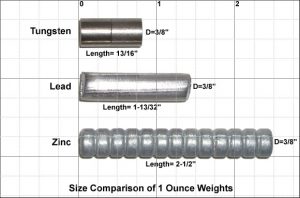 Figure 1 – Density Comparison of Popular Weight Types
Figure 1 – Density Comparison of Popular Weight Types